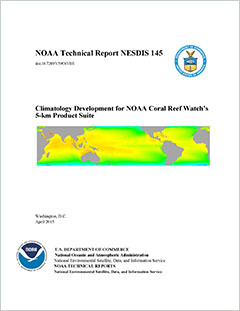-
Home
-
Data & Publications
-
Regional Portals
- About Regional Portals
- Florida
- Navassa Island
- Puerto Rico
- Flower Garden Banks
- U.S. Virgin Islands
- American Samoa
- Commonwealth of the Northern Mariana Islands
- Federated States of Micronesia
- Guam
- Main Hawaiian Islands
- Republic of the Marshall Islands
- Northwestern Hawaiian Islands
- Republic of Palau
- Pacific Remote Island Areas
-
CRCP Activities
- Glossary
Climatology Development for NOAA Coral Reef Watch's 5-km Product Suite

The U.S. National Oceanic and Atmospheric Administration (NOAA) Coral Reef Watch (CRW) program has used a 50-km resolution "Heritage" analysis of satellite sea surface temperature (SST) observations to monitor coral reef thermal stress for more than 15 years. The most frequently requested upgrade by coral reef managers and scientists has been for increased spatial resolution. The recent operational production of a satellite-based, global SST analysis at 5-km resolution has provided the basis for high-resolution monitoring of thermal conditions not only in oceanic waters, but also with increased coverage at and near coral reef locations. Evaluating thermal stress on coral reefs requires knowledge of historical baseline temperature (climatology) at the same spatial resolution to identify and assess anomalous temperatures. This report documents the development of a 5-km SST climatology for use with the 5-km SST analysis.
The climatology was developed using a NOAA climate data record for SST: the 4-km Advanced Very High Resolution Radiometer Pathfinder Version 5.2 SST (PFv5.2) dataset for 1985-2012. This period is much longer than that used in CRW's Heritage 50-km climatology (1985-1990 and 1993) and, because of the warming trend in recent decades, the new climatology was adjusted using local temperature trends to match the Heritage product period. This was undertaken to maintain consistency of the new monitoring products with the Heritage products. In general, not all SST datasets are identical (e.g., due to differences in instrument frequencies, algorithms and water depth used for validation), so the PFv5.2 SST climatology was bias adjusted to better resemble the 5-km SST analysis, providing better consistency between the SST and climatology for producing anomaly-based products. The bias-adjusted monthly climatology was then re-gridded to the 5-km SST grid for application in the thermal stress monitoring product suite.
Recent thermal stress events and associated observations of coral bleaching provide a means to evaluate the performance of the thermal stress monitoring products. Initial comparisons of thermal stress with bleaching reports from the Mariana and Hawaiian archipelagos and the Florida region during 2013 and 2014 indicate that the high-resolution thermal monitoring products are performing well.
Development of the high-resolution temperature climatology documented in this report provides a key component of CRW's next-generation high-resolution global coral bleaching thermal stress satellite monitoring products. The 5-km products, monitoring at or near the scale of coral reefs, have provided unprecedented spatial and temporal resolution for the management of coral reefs worldwide and have been enthusiastically employed by numerous resource managers and other coral reef ecosystem stakeholders.
Citation:
Heron, S. F., Liu, G., Eakin, C. M., Skirving, W. J., Muller-Karger, F. E., Vega-Rodriguez, M., De La Cour, J. L., Burgess, T. F. R., Strong, A. E., Geiger, E. F., Guild, L. S., Lynds, S.. (2015). Climatology Development for NOAA Coral Reef Watch's 5-km Product Suite. Technical Report NESDIS 145. National Oceanic and Atmospheric Administration's National Environmental Satellite, Data, and Information Service, Coral Reef Watch, College Park, MD. 21 p.
doi:10.7289/V59C6VBS
For more information contact:


